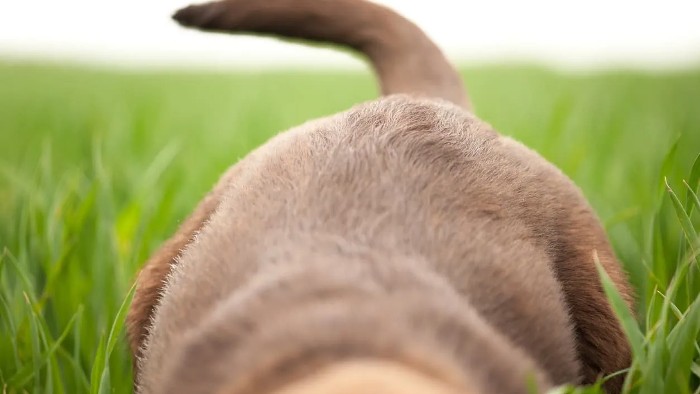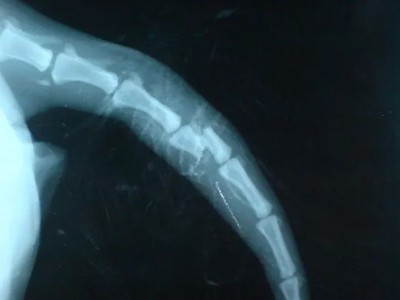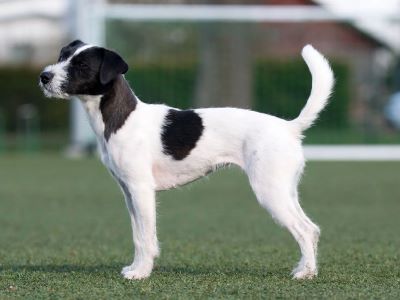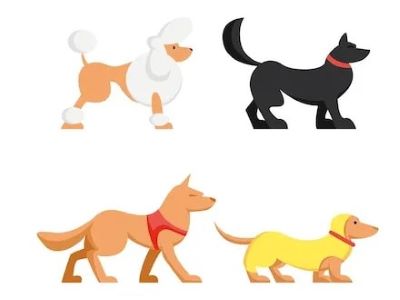If have a dog then you must know the happiness and excitement of your dog when you return from work, when he is getting excited to play or when you are giving him his favourite treat. The one thing that is common in all this display of emotion is tail wagging.

Dogs are prone to wag the tail and it is common in them. Whether they are angry, hungry, happy or excited their every emotion is well exhibited by their tail. But have you ever wondered what is a dog’s tail made of?
Through our blog, “What is a dogs tail made of?” we will quench this query.
Why Tails Matter?
A dog’s tail matters a lot, it is as important as other parts of the body. Here is why it matters:
- The dog’s tail is important as it regulates the movement. It helps dogs maintain balance when running, jumping or turning around. The tail shifts in the opposite direction when the dog moves acting as a counterweight.
- The dog’s tail is an indicator of their mood. Their tail expresses a lot about them. It shows whether they are happy, sad, anxious or angry. It is their way of communicating with us as well as other dogs.
- Dog’s tail also helps them to stay warm, dogs mostly curl it around their nose during cold to feel warm. Breeds like Shiba Inu and Siberian husky are more prone to this kind of behaviour.
What Is a Dogs Tail Made Of?
Here is the anatomy of a dog’s tail:

Bones
A dog’s tail is an extension of their spine. It is made up of small bones which are directly connected to the cartilage. The bones in a dog’s tail are known as vertebrae.
The number of vertebrae in a dog’s tail ranges from 6 to 23. This number of bones varies depending on the size and breed of the dog. The tail of a dog also acts as a cohesion site for muscles and ligaments.
Muscles
A dog’s tail has muscles which help them to control the movement and position dog. The important muscles in a dog’s tail are:
- Sacrococcygeal muscles: This muscle coextends the dorsal and the ventral aspects and connects it to the sacrum and the coccyx bones at the end of the spinal cord.
- Intertransversarius muscles: It is a muscle that with the help of lateral flexion lies between the vertebrae and the transverse processes.
- Coccygeus muscle: This muscle originates from the ischium and connects with the caudal vertebrae which are at the head end of the body. It helps in the elevation of the tail.
Nerves
A dog’s tail has nerves which send signals to the brain, this is the reason they do feel pain in the tail. The nerves in the tail innervate the muscles, anal sphincter and the skin. The main nerves in a dog’s tail are the caudal nerves.
The caudal nerves in the dog’s tail are branches of the sacral and coccygeal nerves. The total number of caudal nerves in a dog’s tail varies between 4 to 7 pairs.
The Function of a Dog’s Tail
Here are the functions of a dog’s tail:

Communication
A dog’s tail is one of the important ways for them to communicate. They wag their tail[1] to express themselves. The tail of a dog exhibits their mood, confidence, intentions, speed and movement.
The straight-up tail of the dog indicates aggression and alertness. If your dog senses any danger or unfamiliarity they tend to raise their tail. The tail tucked down indicates the dog is surrendering himself and stating that he is not a threat.
If the dog’s tail is held upwards then it exhibits the confidence in dog. To express the excitement the dog will wag the tail rapidly.
Balance
The dog’s tail helps them to maintain balance when they are running, turning or jumping. The dog’s tail acts as a counterweight which helps the body to shift in the opposite direction.
Due to this counterweight by the tail, a dog can change direction easily and quickly without affecting its stability. It also helps dogs to swim.
Expression
Dog use their tails to express themselves and their personalities. The dog’s tail expresses their individuality and preferences. The tails of some breeds are thick and furry, whereas some have thin and short tails.
The tails of a few breeds are curled up while many have straight tails. A dog’s way of expressing itself through its tail may also vary depending on the breed.
The Diversity of a Dog’s Tail
You might have often noticed the diversity in dog tails, some tails are short some are furry, and some are thin. Here’s how diverse a dog’s tail is:

- Curl tail: Breeds like Pugs, Basenjis and Bulldogs have this curl tail. The tails of dogs are either slightly curved or curved in full loop.
- Bobbed tail: Dobermans, Pembroke, Australian shepherds and Wiesh corgis are the breeds having bobbed tail. Bobbed tails are short and stumpy. Due to a mutated gene, there is the development of fatty tissue nub in this tail.
- Tufted tail: Poodles have this type of tail. This tufted tail is mostly bushy and tufted hair at the end.
- Stickle tail: breeds like Chihuahuas, Siberian Huskies and malamutes have this stickle tail. These tales are curved and hold back of dog’s body. Stickle tails are facing towards the dog’s head.
- Swimmer or otter tail: Breeds like Labrador Retrievers, Golden Retrievers and Newfoundlands have this type of tail. Swimmer or otter tails are thick with a slight curve. This slight curve helps the dog to swim efficiently.
- Whip tail: This type of tail is long, straight and thin. Breeds like Greyhounds, Whippets and Salukis have this whip tail.
- Plume tail: Breeds like Pomeranians, Samoyeds and Keeshonds have this type of tail. Plume tails are long, feathered and fluffy in appearance.
- Docked tail: These docked tails are not natural they are artificial. These tails are cut short however this practice is banned in many parts of the world. Generally breeds like Rottweilers, Schnauzers and Cocker Spaniels are subjected to have docked tails.
The Health of a Dog’s Tail
Here are some health problems related to dog’s tail:

Tail injury
A dog’s tail is often prone to getting damaged or injured which leads to tail injury. Tail injury can be caused if stepped on the tail, if the tail gets slammed into a door, or even if it gets bitten by other dogs.
This tail injury can further lead to bleeding, bruises, infection and in the worst case even fracture. It is not easy to recover the tail injury in dogs as they have the habit of their tail being constant work.
To treatment of tail injury depends on the seriousness of the injury. If the injury is not serious then it can be treated with medications, but if it is due to infection and fracture then surgery might be required.
Limber tail
In this condition generally, the tail becomes limp, swollen at the base and soft. Limber tail is the result of over-exertion, exposure to cold, dehydration, or due to over-exercising.
To treat the limber tail your vet may prescribe the anti-inflammatory drugs to your dog. Apart from this, you may need to provide your dog with a warm pack and proper rest.
Happy tail
Unlike the name, this condition has nothing happy but only pain for your dog. This condition happens when your dog’s tail gets injured due to wagging. If your dog is wagging its tail very rapidly and it hits a hard surface then can lead to a happy tail condition.
As mentioned by Dr. Genell McCormick DVM, in petmd, "Happy tail syndrome is a condition where dogs cause damage to the tip of their tails from striking surfaces. Many times, this condition occurs when they are wagging their tail, which is why it’s coined happy tail syndrome."
Due to this the tail of the dog can bleed, swell and get infected. To treat this condition antibiotics, bandaging and cleaning of the wound may be required.
Tail docking
Tail docking[2] is the process in which a dog’s tail is shortened artificially by cutting it. This practice is considered unethical and banned in many parts of the world. Tail docking gives nothing but pain and discomfort to your dog.
If this tail docking is not performed properly then can lead to infection and nerve damage. This can also make your dog’s behaviour extremely aggressive.
Other problems
Apart from all those problems the other problems related to dog tails are tumours, cyst formation, parasites, allergic reactions and dermatitis. So if you notice a lump, hair fall, itching or any allergy on the dog’s tail consult a vet immediately.
FAQs
Is a dog’s tail a bone or cartilage?
Yes, a dog’s tail has a bone and cartilage. The dog’s tail has a small bone known as vertebrae. The vertebrae are connected with cartilage, which allows the tail to move flexibly in every direction. Not only bone and cartilage but the dog’s tail consists of nerves, blood vessels and muscles too.
Can dogs feel pain in their tails?
Yes, dogs can feel pain in their tails. The tail is also an important part of a dog’s body just like any other part or organ. Their tail does have nerves which like other organs send the signal to the brain when feel pain. If your dog whines on touching the tail then he is having pain in the tail.
Does a dog’s tail have a purpose?
Yes. dog’s tail does have a purpose. It helps dogs maintain balance and movement. It is also an indication of the dog’s mood. From the dog’s tail movement, you can figure out whether he is happy, sad, angry or excited.
What is a dogs tail made of?
A dog’s tail is made up of bones and cartilage, it also consists of muscles, nerves and blood vessels. A dog’s tail is made of bones called vertebrae. The number of vertebrae ranges from 6 to 23 depending upon the dog’s breed and size.
What is a happy tail?
Dogs wag their tail and it has a lot to do with their mood. If your dog is happy he will wag tail from right to left. It is just their way of showing their emotion, however, it can be dangerous too if your dog wags the tell rapidly. So if your dog gets injured due to tail wagging it is called a happy tail condition.
Conclusion
We hope that through this blog, “What is a dogs tail made of?” we have successfully provided you the information regarding a dog’s tail anatomy. The tail being a significant part of their body should be taken pepper care of.
Do not indulge in any unethical practice with your dog’s tail and on noticing even the slightest change consult a vet.
Reference:
- Ren, W., Wei, P., Yu, S., & Zhang, Y. Q. (2022). Left-right asymmetry and attractor-like dynamics of dog’s tail wagging during dog-human interactions. iScience, 25(8), 104747.
- Wikipedia contributors. (2023c, November 10). Docking (dog). Wikipedia.



